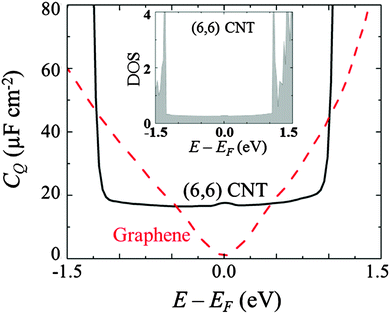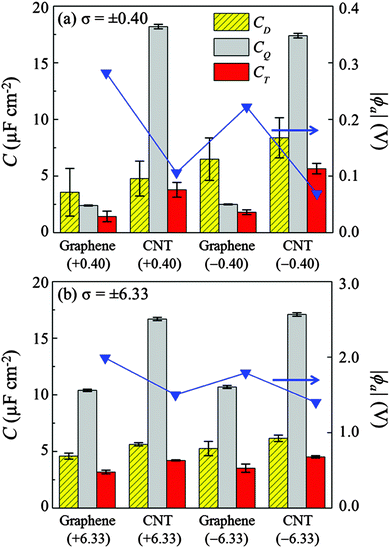 Open Access Article
Open Access ArticleCreative Commons Attribution 3.0 Unported Licence
Correction: Relative contributions of quantum and double layer capacitance to the supercapacitor performance of carbon nanotubes in an ionic liquid
Alexander J.
Pak†
,
Eunsu
Paek†
and
Gyeong S.
Hwang
*
Department of Chemical Engineering, The University of Texas at Austin, Texas 78712, USA. E-mail: gshwang@che.utexas.edu; Fax: +1 512 471 7060; Tel: +1 512 471 4847
First published on 20th August 2014
Abstract
Correction for ‘Relative contributions of quantum and double layer capacitance to the supercapacitor performance of carbon nanotubes in an ionic liquid’ by Alexander J. Pak, Eunsu Paek and Gyeong S. Hwang, Phys. Chem. Chem. Phys., 2013, 15, 19741–19747.
The following errata were found in the published article. However, the overall conclusions of the original article remain unaffected.
1. In our analysis, the DOS was mistakenly underestimated by a factor of two. As a result, the y-axis labels for the DOS and CQ in Fig. 5 should be doubled and are corrected below.
 | ||
| Fig. 5 Comparison of the quantum capacitance (CQ) between the (6,6) CNT and graphene electrodes. EF indicates the Fermi level. The inset shows the DOS (in eV−1 Å−1) of the CNT. | ||
2. The discussion of Fig. 5 on p. 19745 should be modified to reflect the corrected DOS and CQ as follows:
(a) “One important feature to note is that the DOS is nearly constant (≈0.29 eV−1 Å−1) when |E| < 1.0 eV…”
(b) “The CQ,CNT exhibits a constant profile with a value around 18.0 μF cm−2 when |ϕC| < 1.0 V”
(c) There is an additional typo which should be corrected as follows: “The approximated DOS in this energy range (≈0.24 eV−1 Å−1) shows good agreement with DFT calculations…”
3. In Fig. 6, the CT and ϕa are subsequently corrected as shown below.
 | ||
Fig. 6 The double layer (CD), quantum (CQ), and total interfacial (CT) capacitance at the listed σ (in μC cm−2). The ( ) indicates the corresponding applied potential (ϕa). ) indicates the corresponding applied potential (ϕa). | ||
4. The discussion of Fig. 6 on p. 19745 should be corrected as follows:
(a) “When σ = ±0.40 μC cm−2 [Fig. 6(a)], the CT for the CNT electrode is predicted to be CT,CNT ≈ 3.8–5.7 μF cm−2 which is 2.7–3.2 times larger than the graphene case with CT,Gr ≈ 1.4–1.8 μF cm−2.”
(b) “However, when σ = ±6.33 μC cm−2 [Fig. 6(b)], CT,Gr and CT,CNT are much more comparable (≈3.2–4.5 μF cm−2) although CT,CNT is around 28–31% larger than CT,Gr.
This is primarily due to the large increase (slight decrease) in CQ,Gr (CQ,CNT) such that both CT,Gr and CT,CNT are primarily limited by the respective CD values.”
5. The conclusion on p. 19746 should be corrected as follows:
(a) “…the CQ of the (6,6) CNT is nearly constant (18 μF cm−2)…”
(b) “However, the enhancement of CT is likely diminished (predicted to be 28–31%)…”
The Royal Society of Chemistry apologises for these errors and any consequent inconvenience to authors and readers.
Footnote |
| † These authors equally contributed to this work. |
| This journal is © the Owner Societies 2014 |
